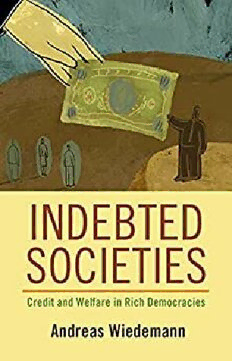
Indebted Societies: Credit and Welfare in Rich Democracies PDF
Preview Indebted Societies: Credit and Welfare in Rich Democracies
IndebtedSocieties In many rich democracies, access to financial markets is now a prerequisite for fullyparticipatinginlaborandhousingmarketsandpursuingeducationaloppor- tunities. Indebted Societies introduces a new social policy theory of everyday borrowingtoexaminehowtheriseofcreditasaprivatealternativetothewelfare state creates a new kind of social and economic citizenship. This book provides arich studyofincomevolatility andrisinghouseholdindebtednessacrossOECD countries.Weakersocialpoliciesandaflexibleknowledgeeconomyhaveincreased costsforhousing,education,andraisingafamily–forcingmanypeopleintodebt. By highlighting how credit markets interact with welfare states, the book helps explain why similar groups of people are more indebted in some countries than others. Moreover, it addresses the fundamental question of whether individuals, states, or markets should be responsible for addressing socio-economic risks and providingsocialopportunities. Andreas Wiedemann is Assistant Professor of Political Science and International AffairsatPrincetonUniversityandtheSchoolforPublicandInternationalAffairs. HeisalsoafacultyaffiliatewiththeNiehausCenterforGlobalizationandGover- nanceandtheCenterfortheStudyofDemocraticPoliticsatPrinceton.Hestudies the comparative political economy of advanced democracies, focusing on eco- nomicinequality,redistributionandsocialpolicies,andelectoralpolitics.Hismost recent work has been published in the American Journal of Political Science and theBritishJournalofPoliticalScience.Wiedemann’sresearchhasbeensupported by the Social Science Research Council, the Andrew W. Mellon Foundation, the HorowitzFoundationforSocialPolicy,andtheKruppFoundation,amongothers. He received the Gabriel A. Almond Award for the Best Dissertation in Compar- ative Politics and the Ernst B. Haas Award for the best dissertation on European PoliticsandSocietiesfromtheAmericanPoliticalScienceAssociation. CambridgeStudiesinComparativePolitics GeneralEditor KathleenThelen MassachusettsInstituteofTechnology AssociateEditors CatherineBoone LondonSchoolofEconomics ThadDunning UniversityofCalifornia,Berkeley AnnaGrzymala-Busse StanfordUniversity TorbenIversen HarvardUniversity StathisKalyvas UniversityofOxford MargaretLevi StanfordUniversity MelanieManion DukeUniversity HelenMilner PrincetonUniversity FrancesRosenbluth YaleUniversity SusanStokes YaleUniversity TariqThachil UniversityofPennsylvania ErikWibbels DukeUniversity SeriesFounder PeterLange DukeUniversity OtherBooksintheSeries ChristopherAdolph,Bankers,Bureaucrats,andCentralBankPolitics:TheMythofNeutrality MichaelAlbertus,AutocracyandRedistribution:ThePoliticsofLandReform MichaelAlbertus,PropertyWithoutRights:OriginsandConsequencesoftheProperty RightsGap SantiagoAnria,WhenMovementsBecomeParties:TheBolivianMASinComparative Perspective BenW.Ansell,FromtheBallottotheBlackboard:TheRedistributivePoliticalEconomy ofEducation BenW.AnsellandJohannesLindvall,InwardConquest:ThePoliticalOriginsofModern PublicServices BenW.AnsellandDavidJ.Samuels,InequalityandDemocratization:An Elite-CompetitionApproach AdamMichaelAuerbach,DemandingDevelopment:ThePoliticsofPublicGoodsProvisionin India’sUrbanSlums AnaArjona,Rebelocracy:SocialOrderintheColombianCivilWar LeonardoR.Arriola,Multi-EthnicCoalitionsinAfrica:BusinessFinancingofOpposition ElectionCampaigns DavidAusten-Smith,JeffryA.Frieden,MiriamA.Golden,KarlOveMoene,andAdam Przeworski,eds.,SelectedWorksofMichaelWallerstein:ThePoliticalEconomyof Inequality,Unions,andSocialDemocracy S.ErdemAytaçandSusanC.StokesWhyBother?RethinkingParticipationinElections andProtests AndyBaker,TheMarketandtheMassesinLatinAmerica:PolicyReformandConsumptionin LiberalizingEconomies Continuedaftertheindex Indebted Societies Credit and Welfare in Rich Democracies ANDREAS WIEDEMANN PrincetonUniversity UniversityPrintingHouse,CambridgeCB28BS,UnitedKingdom OneLibertyPlaza,20thFloor,NewYork,NY10006,USA 477WilliamstownRoad,PortMelbourne,VIC3207,Australia 314–321,3rdFloor,Plot3,SplendorForum,JasolaDistrictCentre, NewDelhi–110025,India 79AnsonRoad,#06–04/06,Singapore079906 CambridgeUniversityPressispartoftheUniversityofCambridge. ItfurtherstheUniversity’smissionbydisseminatingknowledgeinthepursuitof education,learning,andresearchatthehighestinternationallevelsofexcellence. www.cambridge.org Informationonthistitle:www.cambridge.org/9781108838542 DOI:10.1017/9781108975209 (cid:2)c AndreasWiedemann2021 Thispublicationisincopyright.Subjecttostatutoryexception andtotheprovisionsofrelevantcollectivelicensingagreements, noreproductionofanypartmaytakeplacewithoutthewritten permissionofCambridgeUniversityPress. Firstpublished2021 AcataloguerecordforthispublicationisavailablefromtheBritishLibrary. ISBN978-1-108-83854-2Hardback ISBN978-1-108-97158-4Paperback CambridgeUniversityPresshasnoresponsibilityforthepersistenceoraccuracyof URLsforexternalorthird-partyinternetwebsitesreferredtointhispublication anddoesnotguaranteethatanycontentonsuchwebsitesis,orwillremain, accurateorappropriate. Contents ListofFigures pagevi ListofTables ix Acknowledgments xi 1 CreditandWelfareinRichDemocracies 1 2 ASocialPolicyTheoryofEverydayBorrowing 26 3 FinancialShortfallsandtheRoleofWelfareStates 57 4 CreditRegimesandPatternsofHouseholdIndebtedness 86 5 BorrowingtoAddressLaborMarketRisks 124 6 BorrowingduringtheLifeCourse 166 7 ThePoliticalandSocioeconomicConsequencesofCreditandDebt 200 8 ImplicationsandConclusion 234 Appendix 251 Bibliography 290 Index 314 v Figures 1.1 HouseholddebtratiosinOECDcountries,1995and2015 page3 1.2 Dominantwaystocopewithincomelossesacrosscountries 5 1.3 UnsecureddebtleverageinDenmark,theUnitedStates,and Germanybyincometertile 7 2.1 Micro perspective: How households address financial shortfalls 37 2.2 Copingwithfinancialshortfalls:Publicandprivateoptions 38 2.3 Macro perspective: How the structure of welfare and credit regimesshapescopingstrategies 46 2.4 Macro perspective: Country-level constellations of coping strategies 47 2.5 Temporaldimensionofincome-smoothingstrategies 51 2.6 Two“models”ofaddressingfinancialshortfalls 52 3.1 Stylizedmodellinkingincomelossandincomevolatility 60 3.2 Incomevolatilityacrosscountriesandhouseholds 64 3.3 Welfarestates’degreeoffinancialbuffer 66 3.4 Employment disruption, lifecourse choices, and net income volatility 69 3.5 Share of unemployed individuals by duration of unemployment 74 3.6 Distribution of children in households by parents’ employmentstatusin2018 79 3.7 Familypoliciesandchildcarecosts 80 3.8 Preferencesforfundingofchildcareandpaidparentalleavein 2012 82 4.1 CreditflowsinOECDcountries,averagesfor1994to2005 93 4.2 CreditpermissivenessscoresacrossOECDcountries 96 4.3 Credit regime permissiveness scores, ranked averages for 2000–2017 97 4.4 Share of households with easy access to credit, averages for 2000–2010 112 vi ListofFigures vii 4.5 DebtburdeninDenmark,theUnitedStates,andGermanyby income 114 4.6 DebtburdeninDenmark,theUnitedStates,andGermanyby liquidsavings 116 4.7 Oddsratiosforcopingstrategies,countryintercepts 119 4.8 Predicted effect of unemployment insurance generosity on householddebtbycreditregimepermissiveness 121 5.1 Initial and long-term unemployment replacement rates in 2016 128 5.2 Average unsecured debt-to-income ratios among the unemployedinDenmark 129 5.3 Baseline effect of unemployment on unsecured debt in Denmark 132 5.4 Effect of unemployment on unsecured debt by financial shortfallinDenmark 133 5.5 Effect of unemployment on unsecured debt by income in Denmark 135 5.6 Average unsecured debt-to-income ratios among the unemployedintheUnitedStates 138 5.7 Variation in unsecured debt levels by employment status in theUnitedStates 139 5.8 Distribution of maximum unemployment insurance benefit generosityinUSstates,1996–2011 142 5.9 Effect of unemployment insurance generosity on unsecured debtamongunemploymentbenefitrecipients 144 5.10 FewerworkhoursandunsecureddebtleverageintheUnited States 146 5.11 Average unsecured debt-to-income ratios among the unemployedinGermany 149 5.12 Likelihoodofusingoverdraftlendingfacilitiesbyemployment statusinGermany 153 5.13 Differences in unsecured debt between unemployed and employedindividualsbeforeandaftertheGermanHartzIV labormarketreform 157 5.14 Effect of home equity reform on household debt among savings-constrained households by employment status in Denmark 162 5.15 Average unsecured debt-to-income ratios among the unemployedbyincome 164 5.16 Copingwithfinancialshortfallsinthelabormarket:Variation acrossandwithincountries 165 6.1 Averageunsecureddebt-to-incomeratiosbylifecoursestages andincomeinDenmark 171 viii ListofFigures 6.2 Effect of life course stages on unsecured debt by income in Denmark 173 6.3 Netchildcarecostsasshareofhousehold netincomeacross families 174 6.4 Effect of home equity reform on household debt among savings-constrained households by employment status in Denmark 176 6.5 Job switches, income changes, and unsecured debt in Denmark 178 6.6 Average unsecured debt-to-income ratios by degree of labor marketparticipationandincomeintheUnitedStates 180 6.7 Average unsecured debt-to-income ratios during unpaid absenceandpart-timeworkintheUnitedStates 181 6.8 UnsecureddebtbyemploymentstatusintheUnitedStates 183 6.9 UnsecureddebtandthecostofchildcareintheUnitedStates 186 6.10 LikelihoodofbankruptcybyfamilytypeintheUnitedStates 187 6.11 Averageunsecureddebt-to-incomeratiosbylifecoursestages andincomeinGermany 191 6.12 EffectoflabormarketstatusondebtrepaymentinGermany 193 6.13 ChildcarecostsanddebtrepaymentinGermany 194 7.1 Distributionoftheeconomicinsecurityindex 214 7.2 Debtleverageandeconomicinsecurityacrosscountries 216 7.3 Creditaccess,riskofjobloss,andsupportforsocialinsurance 219 7.4 Debt leverage and support for social insurance across countries 221 7.5 Wealth,debtleverage,andsupportforsocialinsurance 225 7.6 Attitudestoward borrowing, debt leverage, and support for socialinsurance 227 7.7 Political ideology, debt leverage, and support for social insurance 230 A.3.1 Weightedgrossandnetincomevolatility 254 A.3.2 Weightednetincomevolatilitybyemploymentstatus 255 A.4.1 Raw values of the credit regime indicators (averages for 2000–17) 256 A.4.2 Distribution of countries along the first two principal components(averagesfor2000–17) 256 A.5.1 Marginal effect of unemployment on debt-to-income ratio bysizeoffinancialgaps,debtnormalizedbypriorincomein Denmark 261 Tables 2.1 Dimensionsofcreditregimes page36 2.2 Socialpolicydimensionsofwelfarestatesandcreditmarkets 44 2.3 Empiricalimplicationsoftheargument 56 4.1 Creditregimeindicators:Measurementanddatasources 95 4.2 Creditandwelfareinstitutions:Summarybycountrycases 122 5.1 Averageemploymenttenureanddurationofunemploymentin 2015(inpercent) 127 5.2 Effect of degrees of labor market attachment on unsecured debtinGermany 151 5.3 EffectofunemploymentonunsecureddebtinGermany 152 5.4 Effect of the German Hartz IV labor market reform on unsecureddebt 158 6.1 Unpaid maternity leave and unsecured debt in the United States 185 6.2 Job switches, income changes, and unsecured debt in the UnitedStates 188 6.3 Absence from work to care for sick children and household debtinGermany 195 6.4 Jobswitches,incomechanges,andindebtednessinGermany 196 7.1 Effectofaccesstocreditandindebtednessonsocialinsurance preferences 210 7.2 Creditaccess,riskofjobloss,andsocialpolicypreferences 220 A.3.1 Definitionofsourcesofincomevolatility 254 A.4.1 Copingstrategiesbycountry,fixedeffectresults 257 A.4.2 Marginal effects of unemployment insurance generosity and creditpermissivenessonhouseholddebt 258 A.4.3 Marginal effects of unemployment insurance generosity and creditpermissivenessonhouseholddebt:robustnesstolagged DV 259 ix
